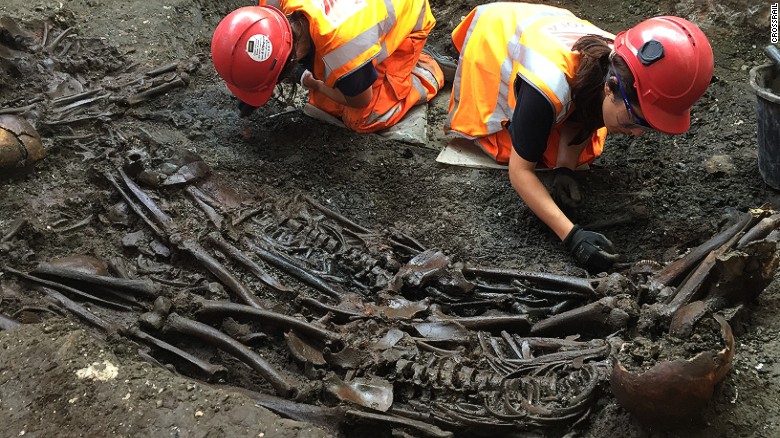
In 1665, the Great Plague of London killed more than 75,000 people in the space of a year, almost a quarter of the city’s population back then. It caused 8,000 deaths per week during its peak in September 1665.
To date, scientists and archaeologists alike have been unable able to state assuredly that the disease behind the deaths was in fact the Bubonic Plague — until now.
DNA sequenced from ancient skeletons dating back to the 17th century was found to match that of the bacteria responsible for the plague, known as Yersinia pestis. The bacteria typically live in fleas found on small animals and rodents, such as rats, which can jump onto humans and bite them to spread the bacteria. Infections typically cause flu-like symptoms, sudden fever and chills, body aches and vomiting, killing up to 60% of people if left untreated.
“For the first time, we understand what caused the 1665 plague,” said Don Walker, senior human osteologist at the Museum of London Archaeology, who led the excavation. “No one really knew what caused it.”
Digging for answers
More than 3,300 burials were uncovered in 2015 at the site known as the Bedlam burial ground, near Liverpool Street station in London, within the New Churchyard archaeological site. They were discovered during the development of the new Elizabeth Line, part of the capital’s Crossrail line, due to start running in 2018. Within the grounds, the teams soon found a mass grave containing 42 skeletons of people suspected to be victims of the Great Plague of London.
“We were hoping to find a plague pit, and we did,” Walker said. “As we knew that the cemetery covered the period of outbreaks of the plague.”
Fragments of pottery, glass and coffins found in the grave were used to date the grounds to between 1650 and 1670, confirming that this was in fact a “plague pit,” — or at least, suspected to be until DNA proved otherwise. Though many historians assumed that the large-scale deaths were caused by the plague, this is the first time evidence has become available to prove it. “The only way you’d know is through DNA,” said Walker.
“This is a very exciting finding, for the history of London, the history of disease, and the history of burials,” added Vanessa Harding, professor of London history at Birkbeck University of London.
Mining for DNA
Finding and sequencing the DNA of these skeletons, which were more than 300 years old, is no easy task, namely because the availability of any DNA to work with is limited. Any Yersinia bacteria on the surface of the skeletons would have died long ago, meaning scientists had to extract DNA from teeth, where enamel helps protect and preserve DNA with less risk of contamination.
“You get much less DNA and need to amplify it,” explained Walker.
Scientists from the Max Planck Institute in Jena, Germany, analyzed DNA extracted from 20 skeletons found in the mass burial pit, as well as 20 skeletons from other parts of the burial ground to compare.
Traces of plague bacteria were found in five of the skeletons sampled from the mass burial pit, with the remaining 15 thought to have lost their traces. The quick fatality of the bacteria means there is less time for them to flourish, and then stay on human remains; DNA has an even lower survival rate when buried in the ground.
Zero traces were seen in those acting as a control group.
“The discovery of the ancient DNA, which has eluded scientists for so long, is yet another piece of the jigsaw that we are piecing together to learn more about the lives and deaths of 16th to 18th century Londoners,” said Jay Carver, the lead archaeologist at Crossrail.
Planning for future outbreaks
The team behind this research believes the DNA of these 300-year-old bacteria could help us understand more about plague infections past and future.
The same bacteria caused the Black Death, which killed an estimated 50 million people during the 14th century. In 2014, this same team of scientists and archaeologists found that skeletons dating back to this pandemic, found in other excavated site in London, also contained Yersinia pestis bacteria. “It was the same disease that kept coming back,” said Walker.
“[This finding] confirms that Yersinia pestis was present in early modern London plague epidemics, and links them epidemiologically with the 14th-century Black Death and the 1720 Marseille Plague,” said Harding. “We still need, however, to understand why the disease manifested itself in so many ways, and whether other pathogens made a significant contribution to these epidemics.”
The researchers believe these DNA investigations can also help us understand today’s plague epidemic, which continues to infect hundreds each year, mainly in Africa. More than 780 cases of the plague were reported in 2013, including 126 deaths. Work has now begun to sequence the full genome of the bacteria.
Historically, the disease spread rapidly and had a high fatality rate, but today’s infections appear to be contracted less easily and spread more slowly. This change in its epidemiology was why some experts questioned whether the Great Plague of London was caused by the same disease.
“Looking at the DNA … could help tell us why the disease has changed in this way,” said Walker. “It’s important for historical research, but will hopefully also contribute to modern medical research.”
As reported by CNN
